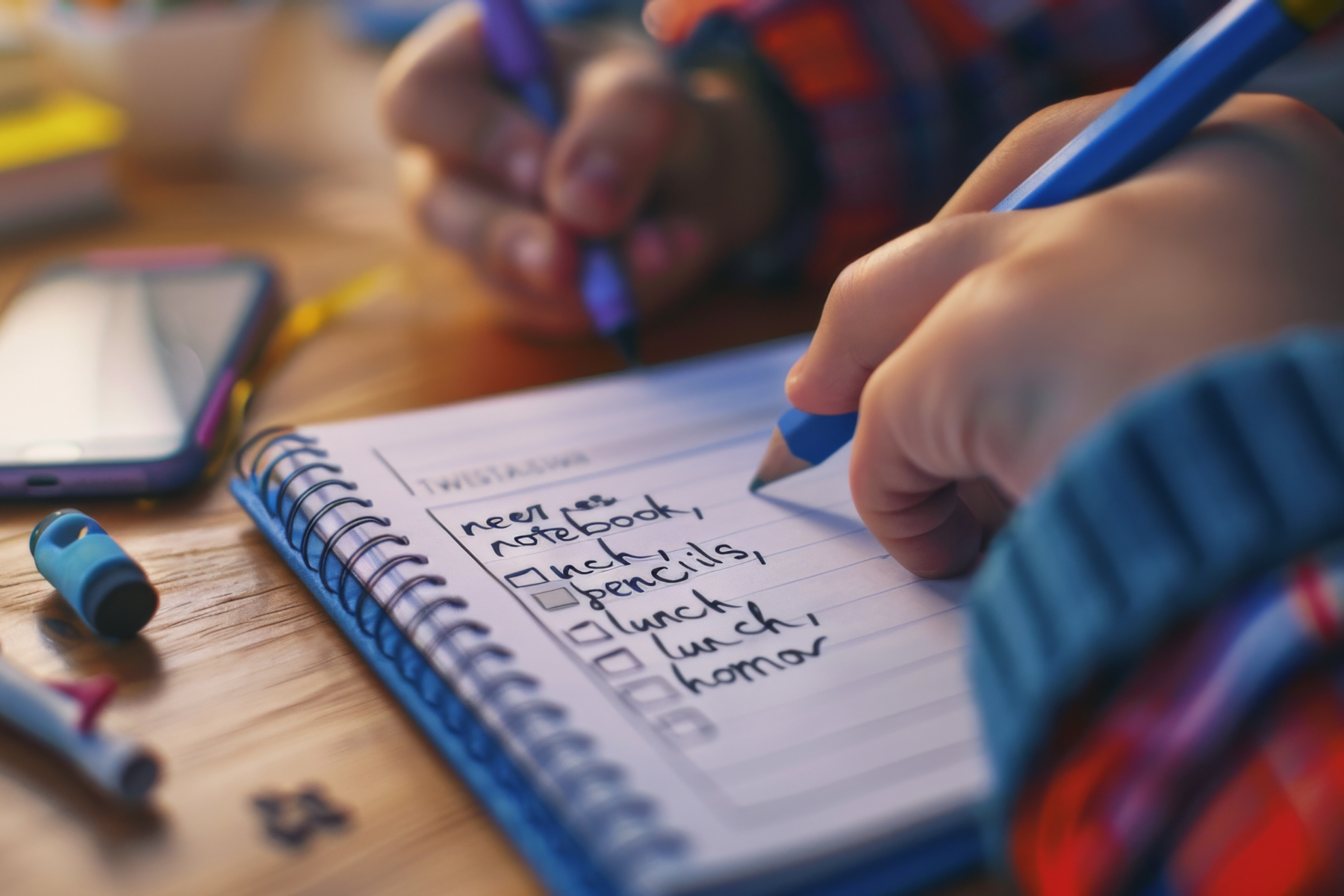Organizing Your Way to a Successful School Year
Reading Time: 4 mins, 29 secs
September is the start of a new school year and a good time to start new habits. Beginning the school year with a structure of time, space, and mechanics will help to get the school year off to a good start.
Make a Plan
The beginning of the school year can be very overwhelming so breaking things down into daily, weekly, and monthly plans is the critical first step towards successful organization. Along with school kicking off many sports, music, and social groups start at this time as well.
Monthly, high-level planning should be an adult-only activity. This will include logistics like transportation, meals, dividing and conquering, as well as recruiting outside help when needed. The saying is true, “It Takes a Village.” This will help you break down the weeks and days when your child can give some input without feeling overwhelmed. A Family Calendar is a great tool to organize everyone with a 100-foot view, there are many traditional calendars to choose from as well as digital options.
Weekly planning is a group effort. If extra-curricular activities are a part of your family plan, make sure to put limits on how many activities can be pursued at one time by each child. This is an opportunity to organize the whole family, not just everyone individually. Everyone can’t be everywhere all at once. Establish your weekly plan on your least busy day of the week with each person having their own weekly planner. Knowing what is in the week ahead will help keep the Sunday Scaries at bay.
Daily activities will vary throughout the week due to afterschool activities but establishing a basic daily routine will help everyone stay organized. Having a daily basic schedule will give kids an expectation of knowing what’s next in their routine. Getting their input will also establish ownership and a sense of control. A visualization board is a handy tool to organize the day. Meal and sleep times are a great structure to build the day around. Knowing breakfast is at 8:00 am and bedtime is 8:00 pm allows for all the time buckets in between to be filled.
Checklists can also be a powerful tool to help kids sort and prioritize their daily tasks. Help your child create a daily checklist of 3-5 tasks to complete each day. These can include things like doing homework, reading time, chores, and even playtime. Following a checklist will help develop your child's ability to strategize tasks and organize time.
Create a Space
September is the time for new school supplies, clothes, shoes, and more stuff. New pens, pencils, uniforms, equipment, and instruments will be making their way into your home throughout the late summer and fall. Creating a space for these items will help everyone not to be overwhelmed by the potential clutter they will cause.
Donate or hand down clothes that no longer fit or are soon to be grown out of that are still in usable condition. If clothing items are unwearable look for a local recycling center that accepts clothing and shoes or use a service like Trashie.
Purge toys, books, and sports equipment that are no longer in use; most donation centers accept these items as well. Other ways to keep items in circulation are through sporting goods swaps and book exchanges.
Reorganize what remains and assess if new hooks, bins, shelves, or baskets are needed to keep things tidy and organized. Once everything is in place it is safe to look at the class supplies needed for this year.
If your family does the traditional back-to-school haul be sure to start by organizing a list of what is needed. Take note of the space available for new items to go — everything should have a place before it comes home.
Backpack – Hook in the Mudroom
Raincoat – Front Closet
Sweaters (2) - Hang in Bedroom Closet
Hoodies (2) – Second Dresser Drawer
Joggers (2) – Third Dresser Drawer
Pants (3) - Hang in Bedroom Closet
Gym Shoes – Mudroom
Unders & Socks – Top Drawer
Pajamas – Bottom Dresser Drawer
Pencils, pens, highlighters, and notepads – Backpack Hanging in Mudroom
Colored Pencils, Glue Sticks and Calculator - Desk drawers
Putting everything in its place as you unpack will help keep track of anything you may have overlooked.
Working at Home
Homework is the least favorite part of the school year for both parents and kids. It does not need to be as dreaded as it is though! Building homework into your day and into your space will assist in its completion with less frustration. Having a designated space in the home where homework can be completed with minimal distraction is key. That can be a desk in the bedroom or the kitchen table with portable bins of supplies. Remember, consistency of space and time are the key organizers of homework. Homework can also be disbursed at different times throughout the day. Every family is different, so if reading aloud homework is best done in the morning in the car on the way to school, remove the distractions and make it the space and time to read.
Preparing for the year ahead by organizing your time and space will give you and your student the confidence to face the challenges of the next grade. And don’t forget, as your family gets into the groove of the new year, you can always adjust and pivot as needed!
Share this article






